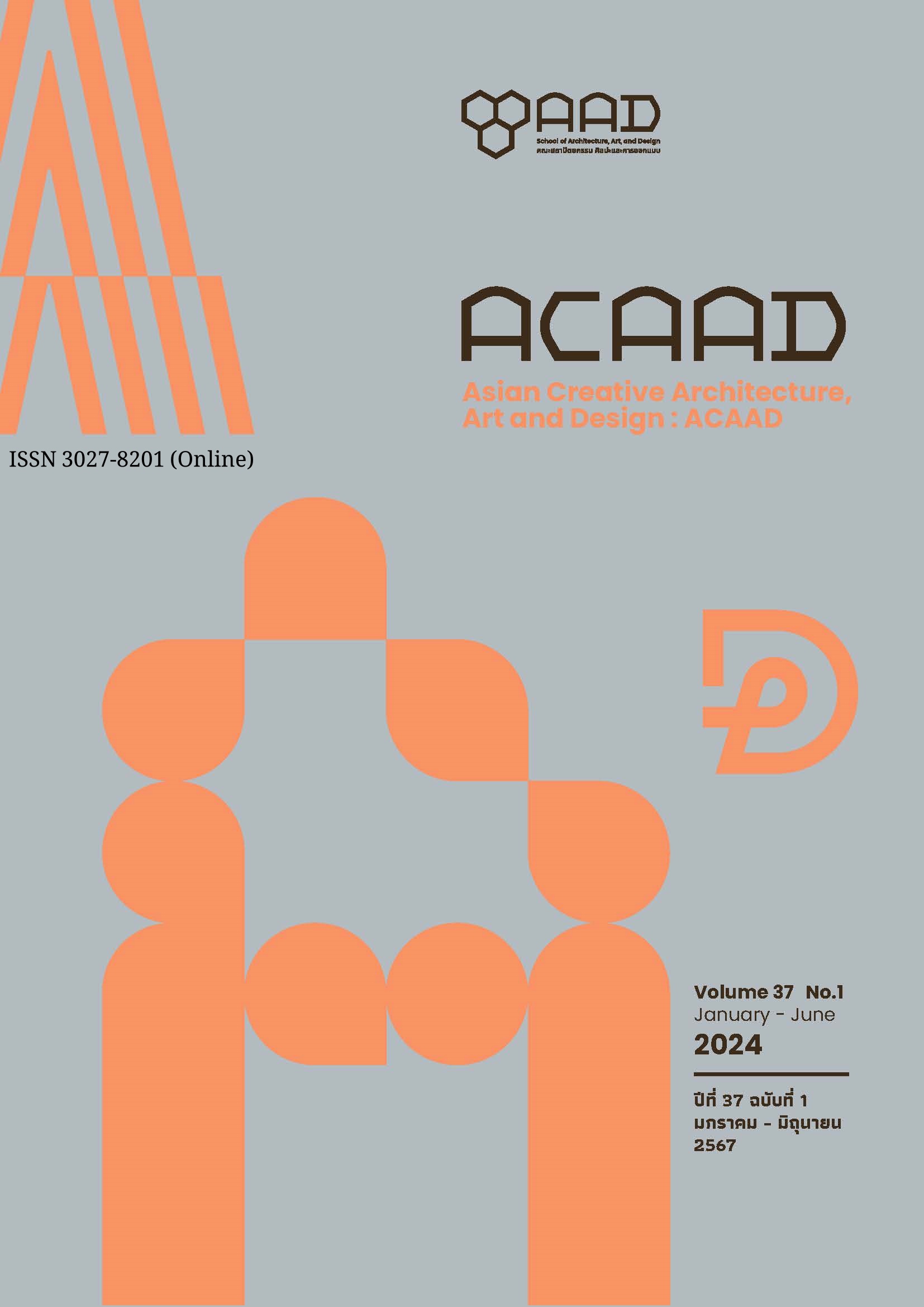The Study of Spatial Attributes of the Wat Ket - Fah Ham - San Pa Koi Connected Area, Chiang Mai, to Identity Characteristics of the Cultural Landscape
Main Article Content
Abstract
This research article aims to explore the spatial components of the Wat Ket, Fah Ham, and San Pa Koi connected areas in Chiang Mai and analyze their roles in defining the identity of the cultural landscape. The research problem is to investigate how exploring spatial components that define the cultural landscape identity in the study area will yield results and how the roles and importance can be identified. The researcher uses qualitative research methods focused on field surveys, cultural landscape surveys, and unstructured interviews as tools for data collection. The sample groups include four selected communities within the district and a group of 44 informants. Subsequently, physical data analysis and interview information are used and presented through descriptions, maps, and illustrations. The research findings indicate that the spatial components defining the cultural landscape identity within the study area can be categorized into nine groups, including open spaces for recreation in the Baan San Pa Khoi community, open spaces along the Ping River near Nawarat Bridge, commercial areas in the San Pa Khoi Market, commercial areas on Kaew Nawarat Road, educational and hospital areas, commercial areas on Charoen Mueang Road, commercial areas on Bumrungrad Road, commercial areas along the Ping River in the area of the 1st Church, Chiang Mai (old building), commercial areas along the Ping River in the Wat Ket area, and the McCormick Hospital area. In terms of analyzing the roles in defining the identity of the cultural landscape, they can be categorized into five roles, including historical and cultural areas, commerce and economic activity areas, architecture and community areas, religious and spiritual areas, and public areas.
Article Details

This work is licensed under a Creative Commons Attribution-NonCommercial-NoDerivatives 4.0 International License.
This work is licensed under a Creative Commons Attribution-NonCommercial-ShareAlike 4.0 International License.
Copyright Transfer Statement
The copyright of this article is transferred to Journal of The Faculty of Architecture King Mongkut's Institute of Technology Ladkrabang with effect if and when the article is accepted for publication. The copyright transfer covers the exclusive right to reproduce and distribute the article, including reprints, translations, photographic reproductions, electronic form (offline, online) or any other reproductions of similar nature.
The author warrants that this contribution is original and that he/she has full power to make this grant. The author signs for and accepts responsibility for releasing this material on behalf of any and all co-authors.
References
Chaiyasit, W., & Sucher, W. (2018). Cultural landscape management for tourism: a case study of a train station, Lamphun province. Journal of Fine Arts, Chiang Mai University, 9(1), 258-300. https://so02.tci-thaijo.org/index.php/fineartsJournal/article/view/97814/96302 (in Thai)
Jackson, J. B. (1984). Discovering the vernacular landscape. Yale University.
Jeenjaitrong, C., & Haocharoen, K. (2020). Cultural landscape of traditional community: a case study of Klong Kwae-om community, Samut Songkhram province. Built Environment Inquiry Journal (BEI), 19(3), 1-21. https://so01.tci-thaijo.org/index.php/arch-kku/article/view/241397/165490 (in Thai)
Kerdsiri, K. (2014). Holistic cultural landscapes of community and vernacular architecture in the area of Songkhla lake watershed. NAJUA: History of Architecture and Thai Architecture, 11, 176-213. https://so04.tci-thaijo.org/index.php/NAJUA/article/view/27539/23629 (in Thai)
Kitika, C. (2020). Integrated cultural landscape conceptual plan with community network participation on a case study of Chang Moi area, Chiang Mai province. NAJUA: History of Architecture and Thai Architecture, 17(1), 152-184. https://so04.tci-thaijo.org/index.php/NAJUA/article/view/244049 (in Thai)
Meinig, D. W. (1979). The interpretation of ordinary landscapes: geographical essays. Oxford University.
Paepuang, P., & Povatong, B. (2021). Adaptation strategies of hotel business entreprenuers in Chiang Mai to Covid-19 situation in 2020. Sarasatr, 4(3), 624-636. https://so05.tci-thaijo.org/index.php/sarasatr/article/view/251235/172140 (in Thai)
Pongsakornvasu, T., & Agmapisarn, C. (2017). A study of boutique coffee shop service marketing strategies: a case study of downtown area in Chiang Mai. Panyapiwat Journal, 9(3), 107-119.https://so05.tci-thaijo.org/index.php/pimjournal/article/view/107093/84738 (in Thai)
Sauer, C. O. (1956). Man's role in changing the face of the earth. University of Chicago.
Siriwatchaipor, P., & Issarathumnoon, W. (2018). Adaptive re-use of vernacular houses for tourism in Wat Ket community, Chiang Mai. Journal of Environtmental Design, 5(2), 26-45. https://so02.tci-thaijo.org/index.php/jed/article/view/133465/119282 (in Thai)
Spirn, A. W. (1998). The language of landscape. Yale University.
Suwatcharapinun, S. (2016). Chiang Mai-Mai: modern architecture in the city of Chiang Mai between the years B.E. 2427-2518. Chiang Mai University. (in Thai)
Tansukanun, P. (2023). The spirit of place: neighborhoods in the city of Chiang Mai. Chiang Mai University. (in Thai)
Thumwimol, V., & Thumwimol, P. (2022). Cultural landscape components of ancient Chaiya, Surat Thani. Sarasatr, 2, 345-357. https://so05.tci-thaijo.org/index.php/sarasatr/about (in Thai)
Tuan, Y. F. (1977). Space and place: the perspective of experience. University of Minnesota.
Vanachayangkul, P., & Dankittikul, C. (2019). Cultural landscape management of Kadkongta, Lampang. Veridian E-Journal, Silpakorn University (Humanities, Social Sciences and arts), 12(6), 1430-1447.https://he02.tci-thaijo.org/index.php/Veridian-E-Journal/article/view/201069/156480 (in Thai)


